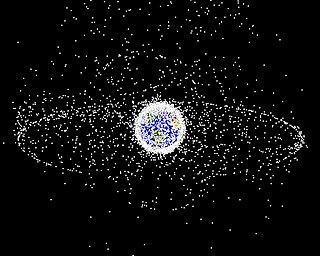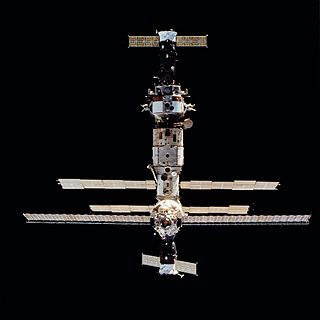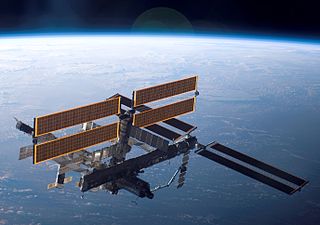Related Research Articles

Atmospheric entry is the movement of an object from outer space into and through the gases of an atmosphere of a planet, dwarf planet, or natural satellite. There are two main types of atmospheric entry: uncontrolled entry, such as the entry of astronomical objects, space debris, or bolides; and controlled entry of a spacecraft capable of being navigated or following a predetermined course. Technologies and procedures allowing the controlled atmospheric entry, descent, and landing of spacecraft are collectively termed as EDL.

On Saturday February 1, 2003, Space Shuttle Columbia disintegrated as it reentered the atmosphere over Texas and Louisiana, killing all seven astronauts on board. It was the second Space Shuttle mission to end in disaster, after the loss of Challenger and crew in 1986.

Space debris are defunct human-made objects in space – principally in Earth orbit – which no longer serve a useful function. These include derelict spacecraft – nonfunctional spacecraft and abandoned launch vehicle stages – mission-related debris, and particularly numerous in Earth orbit, fragmentation debris from the breakup of derelict rocket bodies and spacecraft. In addition to derelict human-made objects left in orbit, other examples of space debris include fragments from their disintegration, erosion and collisions or even paint flecks, solidified liquids expelled from spacecraft, and unburned particles from solid rocket motors. Space debris represents a risk to spacecraft.

On January 28, 1986, the Space Shuttle Challenger broke apart 73 seconds into its flight, killing all seven crew members aboard. The spacecraft disintegrated 46,000 feet (14 km) above the Atlantic Ocean, off the coast of Cape Canaveral, Florida, at 11:39 a.m. EST. It was the first fatal accident involving an American spacecraft while in flight.

STS-36 was a NASA Space Shuttle mission, during which Space Shuttle Atlantis carried a classified payload for the U.S. Department of Defense (DoD) into orbit. STS-36 was the 34th shuttle mission overall, the sixth flight for Atlantis, and the fourth night launch of the shuttle program. It launched from Kennedy Space Center, Florida, on February 28, 1990, and landed on March 4, 1990.

STS-53 was a NASA Space Shuttle Discovery mission in support of the United States Department of Defense (DoD). The mission was launched on December 2, 1992, from Kennedy Space Center, Florida.

STS-63 was the second mission of the US/Russian Shuttle-Mir Program, which carried out the first rendezvous of the American Space Shuttle with Russia's space station Mir. Known as the 'Near-Mir' mission, the flight used Space Shuttle Discovery, which lifted off from launch pad 39B on February 3, 1995, from Kennedy Space Center, Florida. A night launch and the 20th mission for Discovery, it marked the first time a Space Shuttle mission had a female pilot, Eileen Collins, and the first EVAs for both a UK born astronaut, Michael Foale, and a US astronaut of African heritage, Bernard A. Harris, Jr. It also carried out the successful deployment and retrieval of the Spartan-204 platform, along with the scheduled rendezvous and flyaround of Mir, in preparation for STS-71, the first mission to dock with Mir.

Linda Maxine Godwin is an American scientist and retired NASA astronaut. Godwin joined NASA in 1980 and became an astronaut in July 1986. She retired in 2010. During her career, Godwin completed four space flights and logged over 38 days in space. Godwin also served as the assistant to the director for exploration, Flight Crew Operations Directorate at the Johnson Space Center. Since retiring from NASA, she accepted the position of professor in the Department of Physics and Astronomy at the University of Missouri.

STS-115 was a Space Shuttle mission to the International Space Station (ISS) flown by Space ShuttleAtlantis. It was the first assembly mission to the ISS after the Columbia disaster, following the two successful Return to Flight missions, STS-114 and STS-121. STS-115 launched from LC-39B at the Kennedy Space Center on September 9, 2006, at 11:14:55 EDT.

The United States Space Surveillance Network (SSN) detects, tracks, catalogs and identifies artificial objects orbiting Earth, e.g. active/inactive satellites, spent rocket bodies, or fragmentation debris. The system is the responsibility of United States Space Command and operated by the United States Space Force.

STS-116 was a Space Shuttle mission to the International Space Station (ISS) flown by Space Shuttle Discovery. Discovery lifted off on December 9, 2006, at 20:47:35 EST. A previous launch attempt on December 7 had been canceled due to cloud cover. It was the first night launch of a Space Shuttle since STS-113 in November 2002.

The Payload Assist Module (PAM) is a modular upper stage designed and built by McDonnell Douglas, using Thiokol Star-series solid propellant rocket motors. The PAM was used with the Space Shuttle, Delta, and Titan launchers and carried satellites from low Earth orbit to a geostationary transfer orbit or an interplanetary course. The payload was spin stabilized by being mounted on a rotating plate. Originally developed for the Space Shuttle, different versions of the PAM were developed:

The Atmospheric Neutral Density Experiment (ANDE) is an experiment using two spherical satellites to measure the effects of atmospheric drag on spacecraft. ANDE is part of the Space Test Program of the United States Department of Defense, and was deployed in September 2006 from the Space Shuttle Discovery.

Discovery and exploration of the Solar System is observation, visitation, and increase in knowledge and understanding of Earth's "cosmic neighborhood". This includes the Sun, Earth and the Moon, the major planets Mercury, Venus, Mars, Jupiter, Saturn, Uranus, and Neptune, their satellites, as well as smaller bodies including comets, asteroids, and dust.
Kosmos 1818 was a nuclear powered Soviet surveillance satellite in the RORSAT program, which monitored NATO vessels using radar. Kosmos 1818 was the first satellite to use the TOPAZ-1 fission reactor. In July 2008, the satellite was damaged, and leaked a trail of sodium coolant.
The Lincoln Calibration Sphere 1, or LCS-1, is a large aluminium sphere in Earth orbit since 6 May 1965. It is still in use, having lasted for over 50 years. The sphere was launched along with the Lincoln Experimental Satellite-2 on a Titan IIIA. It is technically the oldest operational spacecraft, but it has no power supply or fuel; it is merely a passive metal sphere. LCS-1 has been used for radar calibration since its launch. It was built by Rohr. Corp. for the MIT Lincoln Laboratory.

2020 SO is a near-Earth object identified to be the Surveyor 2 Centaur rocket booster launched on 20 September 1966. The object was discovered by the Pan-STARRS 1 survey at the Haleakala Observatory on 17 September 2020. It was initially suspected to be an artificial object due to its low velocity relative to Earth and later on the noticeable effects of solar radiation pressure on its orbit. Spectroscopic observations by NASA's Infrared Telescope Facility in December 2020 found that the object's spectrum is similar to that of stainless steel, confirming the object's artificial nature. Following the object's confirmation as space debris, the object was removed from the Minor Planet Center's database on 19 February 2021.
Radar calibration satellites are orbital satellites used to calibrate ground-based space surveillance radars. There are two types: active and passive.
References
- ODERACS 2A National Space Science Data Center (NASA GSFC)
 This article incorporates text from this source, which is in the public domain .
This article incorporates text from this source, which is in the public domain .